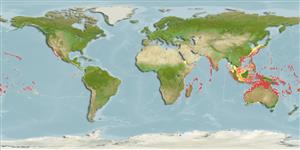Common names from other countries
Environment: milieu / climate zone / depth range / distribution range
Ecologia
; intervalo de profundidade 2 - 100 m (Ref. 8423). Tropical
Indo-Pacific: from Mauritius to Hawaii and Japan.
Length at first maturity / Tamanho / Peso / Idade
Maturity: Lm ? range ? - ? cm
Minimum depth from Ref. 81753. Found along the neritic zone (Ref. 97241), in littoral to sublittoral waters at depths of 10 - 20 m (Ref. 77016). Inhabits reefs and coral rubble (Ref. 81753).
Life cycle and mating behavior
Maturidade | Reprodução | Desova | Ovos | Fecundidade | Larvas
Members of the order Decapoda are mostly gonochoric. Mating behavior: Precopulatory courtship ritual is common (through olfactory and tactile cues); usually indirect sperm transfer.
Davie, P.J.F. 2002. (Ref. 8423)
Status na Lista Vermelha da IUCN (Ref. 130435)
Status no CITES (Ref. 108899)
Not Evaluated
Not Evaluated
Uso pelos humanos
| FishSource |
Ferramentas
Mais informação
Idade/Tamanho
Crescimento
Comprimento-peso
Comprimento-comprimento
Morfologia
Larvas
Abundância
Fontes da internet
Estimates based on models
Preferred temperature
(Ref.
115969): 24.5 - 29, mean 27.9 (based on 1402 cells).
Categoria de preço
Unknown.
